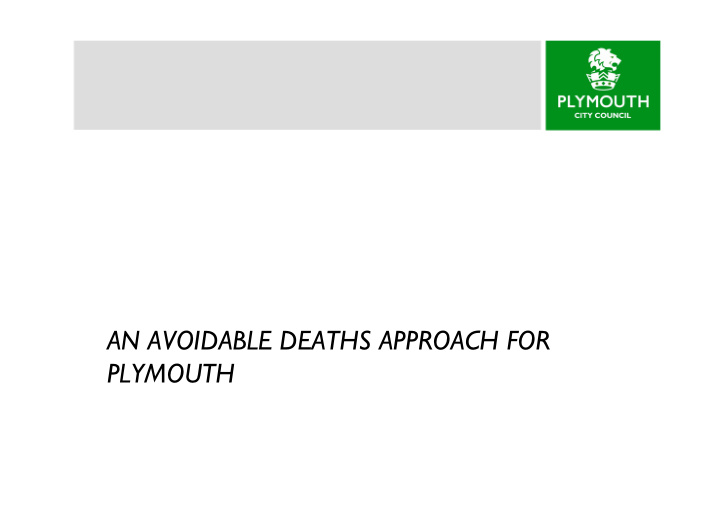



AN AVOIDABLE DEATHS APPROACH FOR PLYMOUTH
THE BIGGER PICTURE
Integrated Commissioning Created ONE system: Integrated governance arrangements � Four Strategies � Commissioning of an integrated health and social care � provider for the city Creating ONE budget: Section 75 between NEW Devon CCG and PCC � Integrated funds £638 million gross (£462 million) � Risk share and financial framework � People and place: Relationships � Trust � Co-location in one building �
Complex Needs � Substance misuse, MH, Homelessness, Offending, Domestic Abuse � 29 services, 5 commissioners working together for 3 years � Whole system approach, shared risk, integrated care, common confidentiality, common core assessment � Open agenda, dispersed leadership, transparency, fostering co-operation, mitigating competition � Must feel to the user like a single system � Two key structures – System Optimisation Group and the Creative solutions forum
Thresholds and labels � Thresholds have become barriers � Labels – diagnostic, behavioural etc – determine what services people get rather than the persons actual presentation � They drive worker identity – ‘specialist X’ rather than describing the actual work � We want to make thresholds permeable, fuzzy and responsive to presenting picture (always a combination of problems and assets) � We set up a structure to lead and support these culture changes
HOW DOES THIS APPLY TO DEATHS?
What are avoidable deaths? Our working definition of an ‘avoidable death’ is those deaths ‘in which modifiable factors may have contributed to the death. These are factors defined as those, where, if actions could be taken through national or local interventions, the risk of future deaths could be reduced’ (* this is taken from the definition of preventable child deaths). Our working definition is also in line with the official ONS definitions (2017, p4) of amenable, preventable and avoidable mortality (where avoidable mortality is the broadest term):
Working Definition � Deaths directly attributable to alcohol � Drug related deaths (traditionally this would mean illegal drugs but there is a case that deaths from abuse of prescription drugs should also be included) � Suicide � Domestic abuse [DA] leading to homicide � Homicide by a person with mental health [MH] problems � Deaths by fire
Why these deaths? There is considerable overlap in terms of: • Polypharmacy – both licit ‘grey’ and illicit • Alcohol • Mental Health problems • Contact with services • Common social determinants • Common localities (excluding suicide) • Existing (but not joined-up) processes for suicide, DRD and DH which we can build on
Our project • To develop an integrated approach at both the strategic and operational level • To adopt methods that consider avoidable deaths within a ‘systems’ context • To look both backwards (audit and review) and forwards (risk identification, preventive activities, culture and system change) • To develop humane ‘end of life’ pathways for the marginalised • To develop and protect the workforce • To provide ‘aftercare’ for victims
Some things we’ve done � Discussion paper produced and approach agreed � Health and Wellbeing Board informal presentation arranged � Bereavement training for complex needs staff � End of life suite in homeless hostel � Bereavement counselling for staff and relatives � Identified a staff team in public health to shape the work � Identified an ‘expert’ group
Expert Group � To review cases from a ‘systems’ perspective � Identify learning where system and/or service change is required � Identify training needs � Develop, prototype and test a risk identification matrix for DRD and ARD (in process) � Develop a risk management process for cases so identified � Produce an annual report for the H&WBB
Workforce development � This is a ‘sub-set’ of the broader complex needs work � Develop a knowledge and skills framework for Plymouth workers � Identify training specific to avoidable deaths – core MH skills, core physical screening skills, risk assessment and risk mitigation skills etc � Develop a culture of prevention which includes PH messaging about death, dying and grief
Systems Learning Identified learning goes to • The System Optimisation Group – a forum of CEO’s of 28 services and 5 commissioners meeting monthly specifically to drive high level system and culture change • The Creative Solutions Forum – meets monthly and made up of practitioners, commissioners and Adult Safeguarding where new practice is modelled and implemented around complex cases
Recommend
More recommend